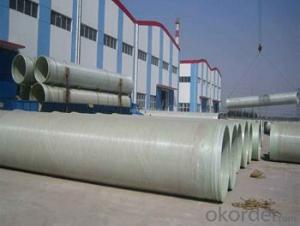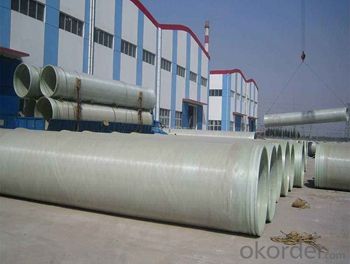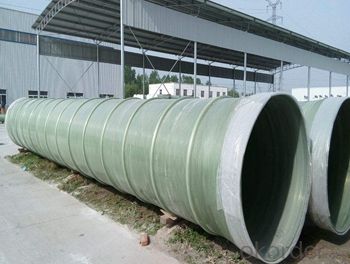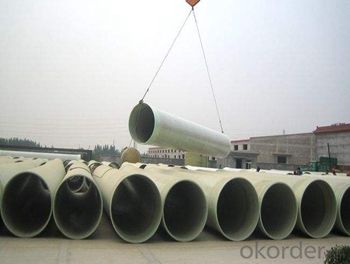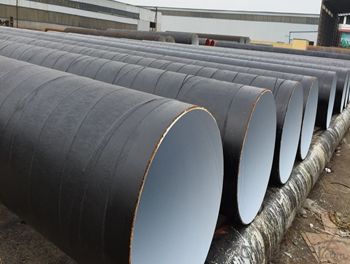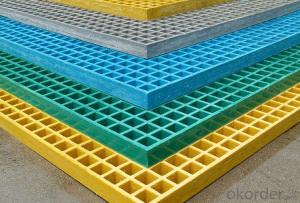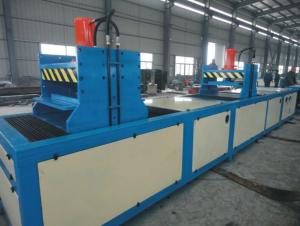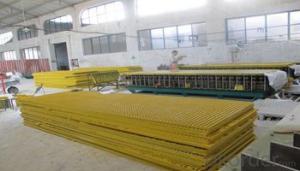FRP Pultrusion Profiles:Lightweight, High Strength, and Best Quality FRP Pultruded Gratings in Various Styles
- Loading Port:
- Tianjin
- Payment Terms:
- TT OR LC
- Min Order Qty:
- 3 m.t.
- Supply Capability:
- 50000 m.t./month
OKorder Service Pledge
OKorder Financial Service
You Might Also Like
PRODUCT DESCRIPTION
Pultruded grating is made by a particular assembly process, which using “I” shape as its main load-bearing and special rod to go through the bearing bar. Pultruded grating include the standard grating and the custom grating, the custom grating can be designed to meet customer’s requirement or special using condition by changing the shape, size and space of the bearing bars, the surface can be covered with lozenge panel, grit panel, or added the anti-slippery sand directly.
FRP pultruded grating has the most characteristics of molded grating, but it has its distinct advantages, it has very high fiberglass content in the loading direction, so it has very high load capability, it has more superiority when used at wide span, so that the basic support will be decreased and the project cost will be reduced accordingly.
SPECIFICATION
Thickness (mm) | Bar width (mm) | Open space (mm) | Open rate (%) | Approx weight (kg/m |
25.4 | 15.2 | 22.8 | 60 | 13.2 |
25.4 | 15.2 | 15.2 | 50 | 15.9 |
25.4 | 15.2 | 10.1 | 40 | 18.5 |
25.4 | 40 | 10.8 | 21 | 14.5 |
38.1 | 15.2 | 22.8 | 60 | 15.8 |
38.1 | 15.2 | 15.2 | 50 | 19.1 |
38.1 | 15.2 | 10.1 | 40 | 22.4 |
50.8 | 25.4 | 25.4 | 50 | 16.6 |
50.8 | 25.4 | 12.7 | 33 | 21.1 |
FEATURES
a. Anti-corrosion and anti-rust
b. Light weight and high strength
c.Good economic benefit
d. Anti- fatigue
e. Safe and anti-slippery
f. Anti-ageing
g. Easy of maintenance
h. Excellent electromagnetism property
FIELDS SERVED
Sewage treatment,
water supply and drainage,
chemical industry,
oil industry,
power engineering,
pulp and paper,
construction engineering,
spinning, marine engineering.
APPLICATION
Operation terrace,
stair walkway,
ground floor,
trench cover,
sidewalk,
foot bridge,
equipment safety fence,
scaffold.
COMPANT DESCRIPTION
CNBM,China National Building Materials Group is a state-owned enterprise in charge of administrative affairs in china building materials industry. Established in 1984, CNBM is a large group corporation of building materials with total assets of 25 billion RMB and a total staff of 30,000.CNBM now owns 200 subordinating firms of solely owned and joint-venture companies.
CNBM International Corporation is one subsidiary of CNBM, we focus on offering good-quality products,professional service and complete solution to our customers. Strong delivery capacity, advanced technology& management, strong financing capability and excellent after-sale service are our advantages in sharing international market.
FAQ
1.Q:Are you factory or trading company ?
A:We are Factory produce FRP machines and FRP products.
2.Q:If can customized by customers requirements?
A:yes,we can produce the machine with customized size.
3.Q:How about the payment?
A:We accept any kind of payment.
4.Q:What is the guarantee?
A:Gurantee is one year.
5.Q:If you can training?
A:yes ,we can training in our factory also can send engineers to your factory training.
PICTURES

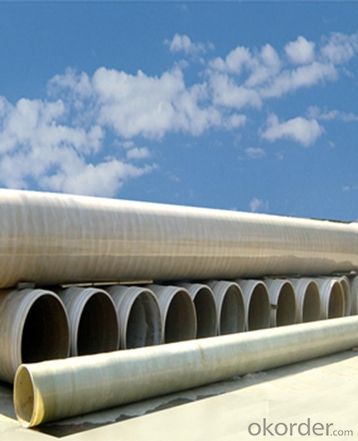
- Q: What does M23 grade of glass fiber reinforced plastic section mean?
- The basic components of the FRP profiles for resin and glass fiber (including cloth, mat etc.), which is based on the fiber (including glass fiber, carbon fiber, organic fiber and other metal and non metal fiber) as reinforcing material, resin (mainly epoxy resin. Polyester resin, phenolic resin) as crosslinking agent, auxiliary and other supporting materials (mainly accessories: release agent, curing agent, catalyst, sealing mould agent, light stabilizer, UV clean water, gel coat) composites. It has a series of excellent characteristics such as high temperature resistance, corrosion resistance, high strength, small specific gravity, low moisture absorption, small elongation and good insulation.
- Q: Are FRP pultrusion profiles resistant to saltwater corrosion?
- Yes, FRP pultrusion profiles are highly resistant to saltwater corrosion. The combination of their fiberglass reinforcement and the corrosion-resistant resin matrix used in their manufacturing make them ideal for applications in marine environments. They are capable of withstanding prolonged exposure to saltwater without degradation or loss of structural integrity.
- Q: Can FRP pultrusion profiles be used in the construction of chemical processing equipment?
- Yes, FRP (Fiber Reinforced Polymer) pultrusion profiles can be used in the construction of chemical processing equipment. FRP pultrusion profiles offer several advantages that make them suitable for such applications. Firstly, FRP pultrusion profiles are highly resistant to corrosion, making them ideal for use in chemical environments where exposure to corrosive substances is common. Unlike traditional materials such as steel, FRP pultrusion profiles do not rust or corrode, ensuring a longer service life and reducing maintenance costs. Secondly, FRP pultrusion profiles are lightweight yet strong, providing excellent structural integrity and load-bearing capacity. This is particularly important in chemical processing equipment, where the materials used must withstand high pressures and temperatures. The strength of FRP pultrusion profiles allows for the construction of robust and durable equipment. Additionally, FRP pultrusion profiles offer design flexibility, allowing for the customization of shapes and sizes to meet specific requirements. This enables the construction of complex chemical processing equipment with intricate designs that are not easily achievable with traditional materials. Furthermore, FRP pultrusion profiles have excellent electrical insulation properties, which can be advantageous in chemical processing equipment where electrical conductivity needs to be minimized to prevent unwanted reactions or hazards. Overall, FRP pultrusion profiles are a reliable and cost-effective choice for the construction of chemical processing equipment. Their corrosion resistance, strength, design flexibility, and electrical insulation properties make them suitable for a wide range of applications in the chemical industry.
- Q: How do FRP pultrusion profiles compare to traditional materials, such as steel or aluminum?
- FRP pultrusion profiles offer several advantages over traditional materials like steel or aluminum. Firstly, FRP profiles are much lighter in weight, making them easier to handle and install. Additionally, FRP profiles possess excellent corrosion resistance, making them a suitable choice for applications in harsh environments. They also have high strength-to-weight ratio, allowing for efficient load-bearing capabilities. Furthermore, FRP profiles are non-conductive and do not require any additional insulation, making them ideal for electrical applications. Lastly, FRP profiles are highly customizable, enabling the design of complex shapes and sizes. Overall, FRP pultrusion profiles provide a cost-effective, durable, and versatile alternative to traditional materials.
- Q: How do FRP pultrusion profiles withstand extreme temperatures?
- FRP (Fiber Reinforced Polymer) pultrusion profiles are engineered to withstand extreme temperatures due to the unique properties of the materials used in their construction. Firstly, FRP pultrusion profiles are composed of a combination of reinforcing fibers, such as fiberglass or carbon fiber, and a polymer resin matrix. These fibers provide excellent strength and stiffness, while the resin acts as a protective binder, holding the fibers together and providing resistance against heat. The reinforcing fibers used in FRP pultrusion profiles have high melting points and are inherently non-combustible, allowing them to maintain their structural integrity even at elevated temperatures. This characteristic prevents the profiles from melting, warping, or becoming brittle under extreme heat conditions. Additionally, the polymer resin matrix used in FRP pultrusion profiles is carefully selected to have a high glass transition temperature (Tg). The Tg is the temperature at which the resin transitions from a rigid, glassy state to a more flexible, rubbery state. By utilizing a resin with a high Tg, FRP pultrusion profiles can withstand extreme temperatures without losing their mechanical properties. Furthermore, the manufacturing process of pultrusion itself contributes to the ability of FRP profiles to withstand extreme temperatures. During pultrusion, the reinforcing fibers are carefully impregnated with the resin matrix and then pulled through a heated die. This process ensures a uniform distribution of the resin throughout the profile, enhancing its resistance to heat and temperature fluctuations. Overall, the combination of high-performance reinforcing fibers, a carefully selected resin matrix, and the pultrusion manufacturing process enables FRP pultrusion profiles to withstand extreme temperatures, making them suitable for a wide range of applications in various industries.
- Q: Can FRP pultrusion profiles be used in the construction and building materials industry?
- Yes, FRP (Fiber Reinforced Polymer) pultrusion profiles can certainly be used in the construction and building materials industry. FRP pultrusion profiles are made by pulling continuous fibers through a resin bath and then into a heated die, which helps to cure the resin and shape the profile. One of the main advantages of FRP pultrusion profiles is their high strength-to-weight ratio. They are incredibly strong and durable, yet lightweight, making them an ideal choice for construction applications where weight reduction is desired. Additionally, FRP pultrusion profiles have excellent corrosion resistance, which is particularly beneficial in environments where moisture, chemicals, or harsh weather conditions may be present. This corrosion resistance extends the lifespan of building materials, reducing maintenance and replacement costs. FRP pultrusion profiles can be used in a wide range of construction applications, including structural components such as beams, columns, and trusses. They are also commonly used as reinforcements in concrete structures, providing additional strength and durability. In addition, FRP pultrusion profiles can be used for cladding, decking, handrails, ladders, and other non-structural elements in buildings. Furthermore, FRP pultrusion profiles offer design flexibility, as they can be easily customized and manufactured to specific shapes, sizes, and properties. This adaptability makes them suitable for a variety of construction projects, from small-scale residential buildings to large-scale industrial complexes. In summary, FRP pultrusion profiles are highly suitable for the construction and building materials industry due to their high strength-to-weight ratio, corrosion resistance, design flexibility, and versatility.
- Q: Can FRP pultrusion profiles be used in the oil and gas industry?
- Yes, FRP (Fiber Reinforced Polymer) pultrusion profiles can be used in the oil and gas industry. These profiles offer excellent corrosion resistance, high strength-to-weight ratio, and low maintenance requirements, making them suitable for various applications in the industry such as pipe supports, cable trays, handrails, and platforms. Additionally, FRP pultrusion profiles are non-conductive, non-magnetic, and possess good fire-retardant properties, making them a safer alternative to traditional materials in hazardous environments.
- Q: Can FRP pultrusion profiles be used in chemical processing plants?
- FRP pultrusion profiles are indeed applicable for use in chemical processing plants. These profiles possess exceptional resistance to corrosion, rendering them suitable for chemical settings that frequently involve exposure to diverse chemicals, acids, and bases. Moreover, FRP pultrusion profiles exhibit a combination of lightness and strength, allowing for customization to satisfy specific design prerequisites, thereby enabling their adaptability for various applications within a chemical processing plant. Additionally, they possess non-conductive electrical properties, proving advantageous in environments necessitating electrical insulation. On the whole, FRP pultrusion profiles present a durable and cost-efficient resolution for chemical processing plants, as they deliver long-term performance and reduce maintenance expenses.
- Q: Are FRP pultrusion profiles suitable for the manufacturing of chemical reactors?
- Yes, FRP (Fiber Reinforced Polymer) pultrusion profiles are suitable for the manufacturing of chemical reactors. FRP pultrusion profiles offer several advantages that make them well-suited for this application. Firstly, FRP pultrusion profiles are highly corrosion-resistant, which is a critical characteristic for chemical reactors that are exposed to harsh chemicals. Unlike traditional materials like steel or concrete, FRP does not corrode or degrade when exposed to a wide range of chemicals, making it a reliable choice for chemical reactor construction. Secondly, FRP pultrusion profiles are lightweight yet strong, providing excellent structural integrity and durability. This allows for the construction of large-scale chemical reactors without adding excessive weight, reducing installation and transportation costs. Furthermore, FRP pultrusion profiles offer design flexibility, allowing for customization to meet specific requirements. They can be easily molded into various shapes and sizes, enabling the construction of complex reactor designs that optimize efficiency and performance. In addition, FRP pultrusion profiles have excellent thermal insulation properties, which can be advantageous in maintaining stable operating temperatures within chemical reactors. This can help improve the overall energy efficiency of the reactor and reduce heat loss. Overall, FRP pultrusion profiles are suitable for the manufacturing of chemical reactors due to their corrosion resistance, lightweight yet strong nature, design flexibility, and thermal insulation properties. These profiles offer a reliable and cost-effective solution for constructing chemical reactors that can withstand the demanding conditions of chemical processing.
- Q: Are FRP pultrusion profiles resistant to fuels?
- Yes, FRP (Fiber Reinforced Polymer) pultrusion profiles are highly resistant to fuels. Due to their inherent corrosion resistance and non-reactive nature, FRP pultrusions can withstand exposure to a wide range of fuels, including gasoline, diesel, and aviation fuels, without deteriorating or losing their structural integrity. This makes them suitable for various applications in industries such as automotive, aerospace, and oil and gas, where resistance to fuel exposure is crucial.
Send your message to us
FRP Pultrusion Profiles:Lightweight, High Strength, and Best Quality FRP Pultruded Gratings in Various Styles
- Loading Port:
- Tianjin
- Payment Terms:
- TT OR LC
- Min Order Qty:
- 3 m.t.
- Supply Capability:
- 50000 m.t./month
OKorder Service Pledge
OKorder Financial Service
Similar products
Hot products
Hot Searches
Related keywords
